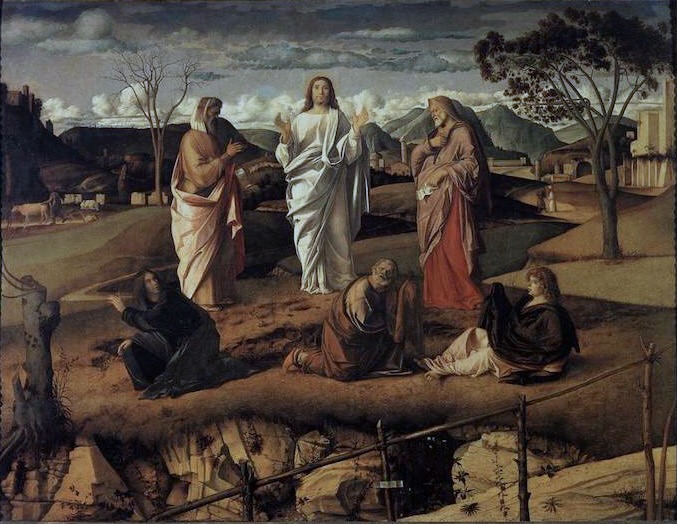All three Synoptic Gospels contain Jesus’ Transfiguration, which we celebrated yesterday. In all the accounts, however, immediately prior to his Transfiguration, Jesus asks his disciples who do others think he is, and then who do they think he is? Peter declares that he is the Christ, the Son of the living God (Cf. Matthew 16:13-16). In response to Peter, Jesus predicts that he will be handed over to the authorities, be killed, and rise on the third day.
Jesus makes similar predictions on two later occasions. All three Synoptic Gospels note that the Apostles did not comprehend such prophecies, and, of course, Peter rebukes Jesus for declaring that he would die. Although Jesus does not mention in these foretellings that he would be crucified, he does tell his disciples that they must daily take up their crosses if they are to be his followers.
The Transfiguration immediately follows. Thus, the Transfiguration can only be fully comprehended in the light of the Cross.
Luke informs us that “about eight days after these sayings, he took with him Peter, John, and James, and went up on the mountain to pray.” “As he was praying, the appearance of his countenance was altered, and his clothing became dazzling white. And behold, two men talked with him, Moses and Elijah, who appeared in glory and spoke of his exodus, which Jesus would accomplish at Jerusalem.” (Luke 9:29-31)
Jesus’ transfigured countenance “shone like the sun.” (Matthew: 17:2) Jesus’ human face radiated the glory of the Father’s Spirit-filled incarnate Son. Together with the transfigured Jesus, Moses and Elijah spoke of Jesus’ “exodus, which he would accomplish at Jerusalem.” What is this “exodus,” this “passing over”?
It pertains to Jesus’ prophecy that he would be crucified and on the third day rise form the dead. The Transfiguration is the prophetic enactment of Jesus’ death and resurrection, that is, through the salvific sacrifice of himself on the cross, he would merit the transforming glory of his resurrection – the everlasting eighth day of the new creation. In so doing, he would fulfill the law (Moses) and the prophets (Elijah).
As the Transfiguration was concluding, Peter declares that it is good that “we are here,” and suggests they build three booths, “one for you and one for Moses and one for Elijah,” though he did not know what he was saying. (Luke 9:33). Meanwhile, “a cloud came and overshadowed” Peter, John, and James, “a cloud” that they fearfully “entered.” From within this Spirit-filled cloud, the Father declared: “This is my Son, my Chosen; listen to him!” (Luke 9:34-35)
Here, the Transfiguration looks back to and reconfirms Jesus’ baptism in the Jordan by John. There, upon the descent of the Holy Spirit, the Father declares: “You are my beloved Son; with you I am well pleased” (Luke 3:22)
Why is the Father pleased with his beloved Son? Within the act of being baptized, Jesus, in the Holy Spirit, obediently commences his Father’s salvific work. At his baptism, Jesus already takes up his Cross, and in so doing, the delighted-Father will transfigure him by raising him gloriously from the dead.

Within the present act of Jesus’ Transfiguration, the Father confirms that Jesus is his beloved Son, his chosen Spirit-filled Christ in, with, and through whom he will vanquish sin and death and bring forth eternal life.
Peter, John, and James are to listen to the Father’s chosen Son. But to what are they to take heed? By entering the Spirit-filled cloud along with Jesus, Moses, and Elijah, they too, in following Jesus, have committed themselves to taking up their crosses. As Jesus must die on the cross and then be raised in three days, so too must they.
They must enact their exoduses, they too must pass over, by means of their crosses, into the transfigured glory of their resurrections. Thus, for both Jesus and his disciples, there is no transfiguration without the glory of the Cross, the only means by which to attain radiant transfigured glory.
But surprisingly, and of theological significance, John’s Gospel does not recount the Transfiguration. For John, Jesus manifests his glory throughout his entire life. John’s whole Gospel is the revelation of Jesus’ glory.
In the Prologue, the Word is the life-giving light through whom the Father created all that is – “the light that enlightens every man.” (John 1:9) The climax of the Prologue comes when the Word becomes man, for, through the Incarnation, “we have beheld his glory, glory as of the only begotten Son from the Father.” (John 1:14)
After he performed his first miracle – changing water into wine at the wedding feast of Cana – the Evangelist notes that Jesus “manifested his glory, and his disciples believed in him.” (John 2:11)
For John, every one of Jesus’ seven miracle-signs manifests his glory. In his high priestly prayer, Jesus beseeches his Father: “Father, glorify me in your own presence with the glory which I had with you before the world was made” (Jn. 17:5, see also 1:20-24). In what manner does the Father glorify Jesus, his incarnate Son?
As in the Synoptic accounts of the Transfiguration, Jesus’ transfigured glory is manifested in his death and resurrection. When Jesus was troubled at the prospect of his crucifixion, he asks his Father to glorify his name. From heaven, the Father declares: “I have glorified it, and I will glorify it again.” (John 12:27-28)
From all eternity, the Father has glorified his Son. He will again glorify his now incarnate Son. By gloriously being lifted up upon the Cross, whereby he is gloriously lifted up into Heaven, we behold the transfigured cruciform resurrected glory of Jesus.
The lesson of the Transfiguration is clear. Throughout our lives, we too, through our daily crosses, are to be transfigured into the glorious risen likeness of Jesus Christ, our Savior and Lord. By “beholding the glory of the Lord,” we “are being changed into his likeness from one degree of glory to another.” (2 Corinthians 3:18)
__________















